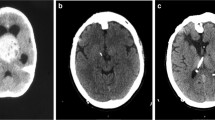Abstract
Background
Long-term results for adult patients who underwent surgery for paediatric brain tumours in the first year of life have not been reported.
Methods
We performed a retrospective study on surgical morbidity, mortality rate, academic achievement and/or work participation in patients who underwent primary tumour resection for a brain tumour as infants in the period from 1973 to 1998. Gross motor function and activities of daily life were scored according to the Barthel Index.
Findings
Thirty-four consecutive children were included. No patient was lost to follow-up. Twenty-two children (65%) underwent gross total resection (GTR), 10 had subtotal resections (STR) and 2 had only partial resection during primary surgery. Nine children were additionally surgically treated for hydrocephalus (HC), many of them with repeat operations for shunt malfunction during follow-up. Three children died within 30 days following GTR of highly vascular tumours. Seventeen (50%) of the infants had high-grade tumours with 1-month, 1-year and 20-year survival figures of 88, 30 and 30%. The corresponding figures for 17 patients treated for low-grade tumours were 94%, 88% and 88%, respectively. Seventeen patients (50%) are still alive as adult long-term survivors at median age of 29 years (range 20 to 43 years). Three died after 29, 30 and 41 years, respectively. At the latest follow-up, 16 out of 17 long-term survivors have a Barthel Index (BI) of 100, while the remaining one has a BI of 40. Two long-term survivors of a high-grade tumour treated 30 and 35 years ago are severely handicapped and have no working capacity. The 15 long-term survivors after treatment for a low-grade tumour are all in daily activity as students (4), in part-time work (3) or full-time work (8).
Conclusion
A brain tumour occurring in the first year of life is a serious threat to the patient and the family, particularly in case of high-grade tumours. In our small cohort, the results from long-term survivors of high-grade tumour group are depressing and confirm the deleterious effect of radiotherapy given to infants decades ago. The infants with low-grade tumours who could be treated with surgical resection without any adjuvant therapy show a good clinical outcome as adults. For parents of these latter patients, the results are far better than feared in advance.

Similar content being viewed by others
References
Bloom HJ, Wallace EN, Henk JM (1969) The treatment and prognosis of medulloblastoma in children: a study of 82 verfied cases. AJR Am Roentgenol 105:43–62
Due-Tønnessen BJ, Lundar T, Egge A, Scheie D (2012) Neurosurgical treatment of low-grade cerebellar astrocytoma in children and adolescents: a single consecutive institutional series of 100 patients. J Neurosurg Pediatr 11:245–249
Hoppe-Hirsch E, Renier D, Lellouch-Tubiana S, Sainte-Rose C, Pierre-Kahn A, Hirsch JF (1990) Medulloblastoma in childhood: progressive intellectual deterioration. Child’s Nerv Syst 6:60–65
Lundar T, Due-Tønnessen BJ, Egge A, Scheie D, Stensvold E, Brandal P (2013) Neurosurgical treatment of oligodendroglial tumors in children and adolescents: a single-institution series of 35 consecutive patients. J Neurosurg Pediatr 12:241–246
Lundar T, Due-Tønnessen BJ, Egge A, Krossnes B, Stensvold E, Due-Tønnessen P, Brandal P (2015) Neurosurgical treatment of brain tumors in the first 6 months of life: long-term follow-up of a single consecutive institutional series. Child’s Nerv Syst 31:2283–2290
Lundar T, Due-Tønnessen BJ, Fric R, Egge A, Krossnes B, Due-Tønnessen P, Stensvold E, Brandal P (2018) Neurosurgical treatment of gangliogliomas in children and adolescents: long-term follow-up og a single institution series of 32 patients. Acta Neurochir (Wien) 160(6):1207–1214
Lundar T, Due-Tønnessen BJ, Fric R, Krossnes B, Brandl P, Stensvold E, Due-Tønnessen P (2019) Neurosurgical treatment of pediatric pleomorphic xantoatrocytomas: long-term follow-up of a single-institution, consecutive series of 12 patients. J Neurosurg Pediatr 8:1–5
Mahoney FI, Barthel DW (1965) Functional evaluation: the Barthel Index. Md State Med J 14:61–65
Mulhern RK, Merchant TE, Gajar A, Reddick WE, Kun LE (2004) Late neurocognitive sequelae in survivors of brain tumours in childhood. Lancet Oncol 5:399–408
Stensvold E, Krossnes BK, Lundar T, Due-Tønnessen BJ, Fric R, Due-Tønnessen P, Bechensteen AG, Myklebust TÅ, Johannesen TB, Brandal P (2017) Outcome for children trated for medulloblastoma and supratentorial primitive neuroectodermal tumor (CNS-PNET) – a retrospective analysis spanning 40 years treatment. Acta Oncol 56(5):698–705
Toescu SM, James G, Phipps K, Jeelani O, Thompson D, Hayward R, Aquilina K (2019) Intracranial neoplasms in the first year of life: results of a third cohort of patients from a single institution. Neurosurgery 84(3):636–646
Author information
Authors and Affiliations
Corresponding author
Ethics declarations
Conflict of interest
The authors declare that they have no conflict of interest.
Ethical approval
For this type of study, formal consent is not required.
Additional information
Publisher’s note
Springer Nature remains neutral with regard to jurisdictional claims in published maps and institutional affiliations.
This article is part of the Topical Collection on Pediatric Neurosurgery
Rights and permissions
About this article
Cite this article
Lundar, T., Due-Tønnessen, B.J., Frič, R. et al. Adult outcome after neurosurgical treatment of brain tumours in the first year of life: long-term follow-up of a single consecutive institutional series of 34 patients. Acta Neurochir 161, 1793–1798 (2019). https://doi.org/10.1007/s00701-019-04014-z
Received:
Accepted:
Published:
Issue Date:
DOI: https://doi.org/10.1007/s00701-019-04014-z




